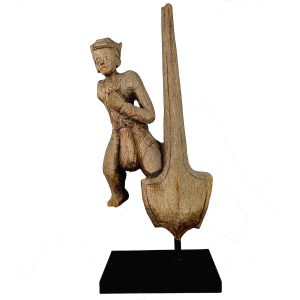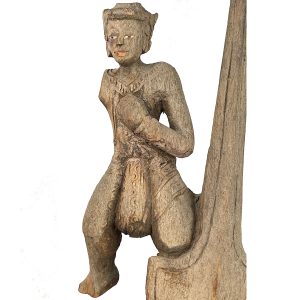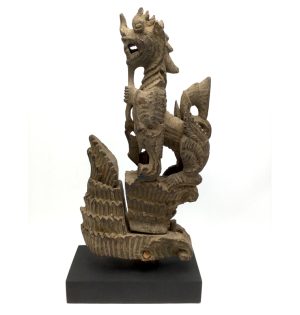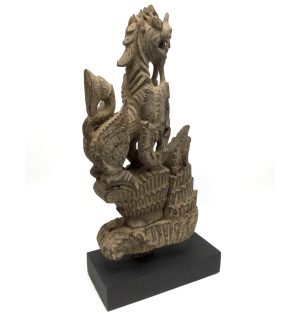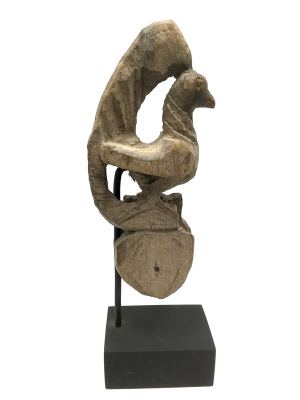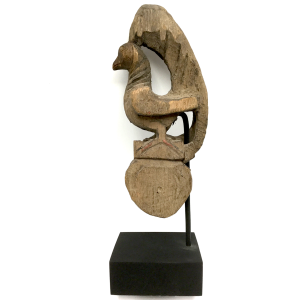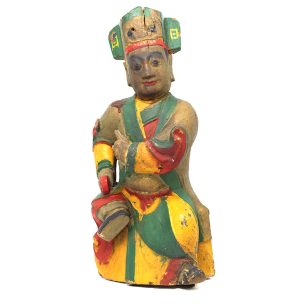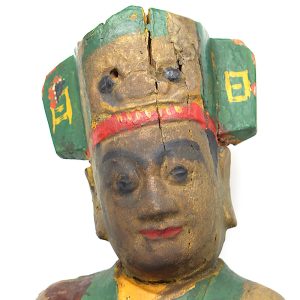Showing 1–12 of 14 results
-
Sale!


$450.00 Original price was: $450.00.$315.00Current price is: $315.00.
H: 23″ W: 10″ D: 5.5″ | CALL 213-568-3030 OR EMAIL [email protected] FOR SHIPPING
This wonderful teak carving may be an indigenous Burmese Nat placed atop a large fleur-de-lis shield reflecting British influence. Wearing a local native sarong (longyi) with an attractive border drawn up between his legs, a decorative pointed collar covers his chest and shoulders, his headgear is pointed at each side, the eyes are mother of pearl, and the red-painted lips are what remains of what was likely a fully painted carving.
-
Sale!


$235.00 Original price was: $235.00.$150.00Current price is: $150.00.
H: 10.5” W: 3.25” D: 2.375” | FREE SHIPPING WITHIN CONTINENTAL U.S. !
This elegant antique heddle-pulley carved from a single piece of Burmese teak is topped by a hamsa, a goose-like bird and a sacred Buddhist symbol of wisdom. Auspicious symbolic animal images are believed protect the weaver, assure quality weaving, and pleases the gods and spirits. It is wonderfully weathered from time and use.
-


$325.00
H: 14.5” W: 17.75” D: 3.375” | FREE SHIPPING WITHIN CONTINENTAL U.S.!
Finely carved figures were attached to ox cart yokes to protect farmers from malevolent spirits who inhabited all seen/unseen sectors of their world. . This beautifully carved ox cart yolk image is a chinthe, a mythical Burmese lion/dragon creature commonly decorating many everyday items. A propitious spiritual and protective guardian, the animalsymbolizes power, courage, and strength. This carving displays the common traits of a lions with a long face, large eyes, a long sharp nose, a lion-like beard, and a flame-like shape on the top of his head. Masterfully carved with careful attention to details, see the deeply incised hairs that cover his body. The 2-part piece is held together with a wooden plug. Though for daily use, Burmese craftsmen created beautiful objects and finished them with the best materials they could afford.
-
Sale!


$245.00 Original price was: $245.00.$150.00Current price is: $150.00.
H: 13” W: 3.75” D: 2.625” | FREE SHIPPING WITHIN CONTINENTAL U.S.
This Burmese teak heddle pulley is topped by a graceful peacock. The peacock symbolizes wholeness, combining all colors with its spread tail and the fleeting nature of all sentient beings. Drawing on old animistic beliefs, old folk art Burmese heddles are decorated with carvings of mythical or auspicious animals providing the weaver protection and assuring good quality weaving. Mounted on wood base.
-
Sale!


$245.00 Original price was: $245.00.$150.00Current price is: $150.00.
H: 14″ W: 2.675” D: 3.5” | FREE SHIPPING WITHIN CONTINENTAL U.S.!
This elegant heddle pulley carved from a single piece of Burmese teak is topped by a peacock, which in Buddhism represents the short-lived nature of all things. Borrowing from ancient animistic traditions, it was believed that auspicious symbolic animal images protected the weaver, assured quality weaving, and pleased the gods and spirits. This antique folk piece is wonderfully weathered from time and use.
-
Sale!


$950.00 Original price was: $950.00.$475.00Current price is: $475.00.
Ht: 17” W: 4.25” D: 4.5” | FREE SHIPPING WITHIN CONTINENTAL U.S.
Chinese puppet theatre thrived, educated and entertained people with puppets that usually had detachable heads. A very popular figure, the Queen Mother of the West is the highest ranking female Taoist deities venerated by women as a powerful, independent deity embodying yin (female energy) who they prayed to for health and long life. Her complex elaborate headdress includes a large outstretched tortoise atop her iconic symbol, the phoenix, all flanked by two nagas under an arch bordered with a scale like finish, a truly unique and impressive image. She is mounted on a modern contemporary frosted acrylic base.
-
Sale!


$265.00 Original price was: $265.00.$165.00Current price is: $165.00.
Ht: 10.625″ W: 3.375″ D: 2.5″|FREE SHIPPING WITHIN CONTINENTAL U.S. !
This elegant antique heddle-pulley carved from a single piece of Burmese teak is topped by a hamsa, a goose-like bird and a sacred Buddhist symbol of wisdom. Auspicious symbolic animal images are believed protect the weaver, assure quality weaving, and pleases the gods and spirits. It is wonderfully weathered from time and use with minor losses with a fine patina. Mounted on a black wood base, this heddle pulley pairs well with item number 11298A.
-


$395.00
This image from Guandong wears typical Taoist priest or shaman attire – an undergarment crossed at the neck, an overcoat clasped at the waist and a double-winged high hat centered with an image of a taotie. The taotie is a mystical animal sometimes on the hat of Taoist priests or shamans as a guardian or…
-


$1,750.00
This rare, vintage spirit mask is from Timor in Indonesia. Their animism is characterized by ritual exchanges between individuals or social groups with ancestral and fertility spirits having a close reciprocal link between the deceased and the secular world as ancestors require sustenance, respect and attention (i.e. offerings), while humans seek advice, good fortune, health…
-

$325.00
H: 12.25″ W: 8.5″ D: 2.25″ | CALL FOR AVAILABILiTY
Timor masks are rare, intense, characterized by large roughly cut eyes and sometimes have no teeth. This one is not completely black from being stored in house rafters and also has no animal hide with hair attached to it. Its surface has darkened unevenly and there are white bits of white especially on the front. Threatening due to its lack of teeth, asymmetrical eyes and their lack of balance, ancestral masks are used in offering rituals designed to drive off malevolent spirits, scare enemies and perform ritual ceremonies and war celebrations.
Additional Information: This rare vintag
-


$485.00
The culture, rituals, tribal and ethnic art of the Dayak (Dyak) of Kalimantan (Borneo), Indonesia is a mix of shamanism, animism and ancestor worship. Dyak festival masks worn on the face or large ones attached to a costume repel malicious spirits from entering communal spaces, insure village safety, protect babies in their carriers and defend…
-


$1,050.00
H: 23.375” W: 13 W: 6” | FOR SHIPPING INFORMATION CONTACT US AT 213-568-3030 or [email protected]
This vintage hudoq Dayak ancestor mask has traditional Dayak features: wing-like separately carved ears attached with rattan that, like this, usually is replaced; long extended triangle nose, rounded arabesque-like ears and eye-holes, gnarled teeth, and geometric and curvilinear painted decorations. This one of three VA masks featured in collection of the Green Goblin in the 2002 Spiderman movie and is set on a museum-quality metal stand.
End of content
End of content

